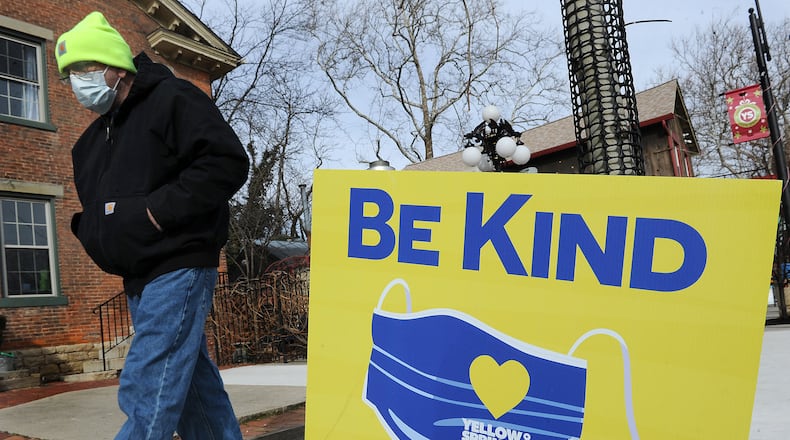We wanted to find out why.
Other than getting vaccinated, masks are the most effective tool to prevent the spread of COVID and reduce its burden on institutions, health authorities have repeatedly said. That’s especially true as omicron causes more breakthrough cases in vaccinated people.
From President Joe Biden, Gov. Mike DeWine, the Ohio legislature and area city councils, elected leaders have not enacted business closures, occupancy limits, restrictions on gatherings or mask mandates like those used earlier in the pandemic.
Meanwhile, the uncontrolled pandemic has sent workers home and disrupted the systems necessary to society, including:
- This past week, more than a dozen local school districts moved to remote learning or canceled classes due to cases among staff and students. That includes schools in Bellbrook-Sugarcreek, Greenon, Lebanon, Tipp City, Troy, Urbana, Valley View, Fairborn, West Carrollton, Northridge, Huber Heights, Mad River, Springboro and Dayton.
- Illness and quarantining means multiple area police departments are posting significant overtime and operating with fewer officers on the ground.
- The Greater Dayton Regional Transportation Authority is temporarily reducing services because of rising staff absences likely due to COVID and lower ridership during the health crisis.
- Dayton-area hospital authorities say the health care system is overtaxed and struggling to provide routine care. Kettering Health and Premier Health have postponed all nonemergency procedures and surgeries requiring an overnight stay.
Experts say occupancy limits or shutdowns likely are not needed at this time as long as everyone wears a good mask in public, indoor spaces.
But these days, in Dayton-area stores, far from all patrons are wearing a mask.
A mask mandate from the state would help, said Rick Hodges, former director of the Ohio Department of Health and the current director of the Ohio Alliance for Innovation in Population Health.
“We know how to control this: Wear a good mask … and get vaccinated,” Hodges said. “Unfortunately, the issue has become politicized and it really comes down to taking care of your neighbor … The power of the mandate is helping to remind us all to take care of our neighbor. I don’t think we should treat it as a crime, but I think most of us will respond by saying, ‘Oh yeah, this reminds me, I’ve got to be aware of other people.’”
Studies show that multilayered face masks filter upwards of 50% to 70% of fine droplets and particles that transmit COVID-19. Respirators like N95 masks, if worn properly, filter out about 95% of airborne particles.
All the tools in the toolbox
About 40% of Ohioans remain unvaccinated and many likely will not get the shot anytime soon because they are either too young or are staunch hold-outs.
Vaccinations have slowed to a trickle. Currently about 5,900 Ohioans get a first dose every day. That’s about 0.05% of the state’s population. At that rate, it would take 20 days for an additional 1% of the population to get their first shot or over 660 days to get the rest of all eligible Ohioans vaccinated.
Vaccination is not the only tool in the toolbox to fight COVID-19, said Amy Rohling McGee, president of the Health Policy Institute of Ohio.
“Vaccination is the most effective and longest lasting protection, but masking also works as well,” she said. “And those two things done in combination offer the best protection.”
Layered prevention strategies provide the highest possible protection, Ohio Department of Health spokeswoman Michelle Fong said. This includes the combination of getting vaccinated, wearing face masks, washing hands frequently, getting tested and staying home if sick, even if symptoms are mild or might just seem like a cold.
Why no state mask mandate?
Ohio Senate Bill 22, which passed last summer over DeWine’s veto, limited the governor and the Ohio Department of Health’s ability to quickly and independently enact health orders.
“Gov. DeWine has made clear that any mandate he issues would be overridden in the state legislature,” Clark County Health Commissioner Charles Patterson said. “Clark County Combined Health District supports Gov. DeWine and his continued position that masking and social distancing work and should be observed in public, especially right now during this surge in cases.”
Representatives for the governor’s office and the Ohio Department of Health said the state is focusing on vaccinations and not considering mandates at this time.
Ohio is at a different stage of the pandemic than in 2020 when health orders were used across the country, DeWine’s press secretary, Dan Tierney, said.
“At this stage of the pandemic, the best way to reduce severe illness is vaccination, not health orders,” he said. “Here in 2022, the COVID vaccines are the most effective protections against the virus. About 70% of adult Ohioans are vaccinated, and a significant number of our most vulnerable Ohioans have received the booster.”
Maintaining up-to-date vaccination, including getting boosted as soon as eligible, remains the best protection against COVID-19 hospitalization and death, Fong said.
“The Ohio Department of Health will continue to promote the best strategies for protection against COVID-19 and continue to share data and information to help Ohioans make informed decisions about their health and well-being,” Fong said.
State Rep. Scott Lipps, R-Franklin, and Ohio Sen. Steve Huffman, R-Tipp City, who chair the Ohio House and Ohio Senate’s health committees, did not respond to requests for comment. Both Lipps and Huffman cosponsored Ohio Senate Bill 22.
Few local mask mandates
A few jurisdictions across Ohio have mask mandates in place — including Columbus — but the vast majority of Dayton-area municipalities have no such rules.
Spokeswoman for Butler County General Health District Erin Smiley said health departments do not have the statutory power to issue a countywide mask mandate. Ohio Senate Bill 22 stripped local health departments of such powers.
In the fall, departments such as Public Health-Dayton & Montgomery County called on local governments to enact mask mandates. But area departments are no longer making such a request.
Leaders of some of the Dayton region’s largest city governments — Dayton, Kettering, Beavercreek, Centerville, Miamisburg and Monroe — said they are listening to what their county health departments tell them to do.
“We’ve been following since the beginning of this whatever Montgomery County public health has told us,” Dayton City Commissioner Matt Joseph said. “They’ve been our experts.”
The two previous times the city of Dayton put a mask mandate in place, it followed advice from Public Health-Dayton & Montgomery County, said Director of the Dayton City Commission office Torey Hollingsworth.
Montgomery County Health Commissioner Jennifer Wentzel is not calling for cities to pass mandates.
“As we have seen throughout the pandemic, that fragmented approaches to the containment of COVID-19 are less successful than those that are unified at a larger scale, with both national or statewide policies having the most effect,” Wentzel said.
She said Public Health-Dayton & Montgomery County continues to encourage face masks and other precautions to reduce the spread of COVID-19.
“Earlier in the pandemic certain measures were mandated with respect to stopping the spread of COVID-19, but we’ve learned a few key things since then,” Wentzel said. “Face mask mandates imposed by local governments will continue to cause unnecessary legal battles among citizens, businesses and governments.”
Wentzel said these skirmishes distract from the most important measure everyone should be taking: getting vaccinated.
What cities are saying
“Should Greene County Public Health make a recommendation to put a mandate in place, then the issue will be brought before council,” Beavercreek Mayor Bob Stone said. “I rely on advice from the professionals.”
Kettering City Manager Mark Schwieterman said the city follows recommendations from the U.S. Centers for Disease Control and Prevention, ODH and Public Health-Dayton & Montgomery County. The city continues to monitor the situation and stay prepared to make changes, Schwieterman said.
City managers for Beavercreek and Kettering pointed out that city employees are required to wear face masks at work.
Miamisburg City Manager Keith Johnson said the city encourages masks but does not have plans for a mandate.
“What drove this before was really action from the governor’s office asking that we do this. That simply has not come down from the governor’s office,” he said.
Centerville Mayor Brooks Compton said the city trusts the small business owners and other organizations to make decisions that are right for them and their patrons.
Monroe City Manager William Brock said the city council has followed recommendations of the Butler County Department of Health.
Brandon Saurber, Hamilton’s public information officer/director of neighborhoods, said he is not aware of any discussions by city leadership to enact a mask mandate at this time.
The exception: Yellow Springs
The small village of Yellow Springs is likely the only municipality in the Dayton region to mandate masks at this time. Masks are required in the central business district indoors and outdoors on public property downtown.
Most of the village’s residents and downtown business owners asked for the requirement, Yellow Springs Village Council President Brian Housh said.
“There was a general call from our local businesses that having that mask mandate in place helped them to enforce their own policies,” he said. “On a nice day in Yellow Springs, our small downtown can get pretty packed.”
Housh said the village has heard from many residents and visitors that they feel safe in Yellow Springs because of the widespread use of masks.
It’s up to individuals
Federal, state and local authorities continue to highly encourage the use of face masks in public, indoor spaces, but they have largely left the choice up to individuals.
Individuals and organizations can take those same proactive measures on their own without it being required by the state, Greater Dayton Area Hospital Association President Sarah Hackenbracht said. Getting vaccinated, wearing a mask and taking other precautions can alleviate the burden on our institutions, for example by preserving the capacity within our hospitals, she said.
“As COVID-19 continues to evolve, Ohioans must make individual choices to protect themselves, their families and their communities,” said Fong with ODH.
About the Author

